
Project Gutenberg's Bowling Catalog E, by Narragansett Machine Company This eBook is for the use of anyone anywhere in the United States and most other parts of the world at no cost and with almost no restrictions whatsoever. You may copy it, give it away or re-use it under the terms of the Project Gutenberg License included with this eBook or online at www.gutenberg.org. If you are not located in the United States, you'll have to check the laws of the country where you are located before using this ebook. Title: Bowling Catalog E Author: Narragansett Machine Company Release Date: June 16, 2018 [EBook #57337] Language: English Character set encoding: UTF-8 *** START OF THIS PROJECT GUTENBERG EBOOK BOWLING CATALOG E *** Produced by ellinora, RichardW, and the Online Distributed Proofreading Team at http://www.pgdp.net (This file was produced from images generously made available by The Internet Archive/American Libraries.)


THE recent revival of this interesting game has resulted in the application of modern principles of system and exactness to Alleys, Pins, and Balls. What would have been very good ten years ago will not answer at all now. The alley in particular must be right from the start and remain so. This can only be expected of experienced builders, using first class materials. We have been building alleys for ten years and by giving them careful study have produced good alleys. This catalogue describes them in every detail. There are alleys and ALLEYS, but there is only one “STANDARD” ALLEY. The statements we make regarding it are facts, borne out by the class of people who use it.

CONSTRUCTION. The beds rest on sleepers supported at their ends by sills running the entire length of the alleys. These may rest on a concrete, cement, or other solid floor, or on posts or piers set 8 ft. apart, or where the ground is firm and dry of a gravelly nature, on flat stones laid on the ground. The sills raise both sleepers and bed clear of the ground or cement, and as there is ample air space beneath them they are not liable to be affected by moisture which nearly always collects in confined places near the ground. The beds are made of strips three inches wide, tongued and grooved on the sides, (see page 14) and are built up by nailing and glueing each strip on top of the preceding one until the bed stands on edge 42 inches high: in this way the strips are firmly driven together and a solid bed secured. The bed is then laid down, screwed to the sleepers and planed.
DURABILITY. This is secured, first by the use of good well-seasoned timber. Second by the ample air space beneath the alleys. As we use large quantities of the Hard White Maple of which the beds are made, we have arranged with several of the largest mills in the country to select from their finest stock the best for our use, shipping in car-load lots. No such timber can be found in any city yards. The Sills and Sleepers are of Selected Hard Pine, known as one of the most durable woods. As none of the woodwork is bedded in cement or in any way closed up there is no tendency to dry rot, and it cannot be affected by any ordinary degree of moisture. By long experience in alley building we have ascertained the most durable materials for different parts and their best forms, features that save wear and avoid early and expensive repairs.

The Standard (Reiskey & Wolf Patent) Adjustable Alleys are constructed in every detail the same as the Standard Bowling Alleys except that the sleepers on which the beds rest are adjustable. The adjusting screws are placed at the ends of the sleepers and rest on the sills as shown above. They are riveted to Iron Shoes that are secured to the sills so that the screws can raise up or draw down the beds. Any deviations of the beds from level, except such as are due to wear, may be corrected by the adjusting screws, and the expense of re-planing avoided or reduced in cost. When it is necessary to plane out a worn spot the worn part may be raised by the screws and the necessity of taking a deep cut of the whole bed avoided.
SECTIONAL ALLEYS. On the Adjustable principle we build sectional Alleys with the beds in sections 12 to 14 feet long and 42 inches wide. After the Adjustable Sleepers are set and leveled, the bed sections are screwed to them and if necessary again leveled by the adjusting screws. Such alleys are as near portable as it has been possible to get alleys and may be moved from Winter to Summer resorts, etc.
BEDS first quality white maple, 3 in. wide, rabbetted on the sides, laid on edge, glued and nailed with cut steel nails.
LENGTH OF BED, 78 ft., width, 41 to 42 in., thickness, 3 in.
SLEEPERS to be of selected hard pine, 6 in. deep, 3 in. wide, placed at an average of 36 in. apart.
SILLS to be of Hard Pine 6 × 6, built of three pieces.
SCORE BOARDS of artificial slate, 20 in. by 27 in. inside frame, ruled to 2 in. squares, framed in oak, with chalk rail.
SCRATCH LINE AND PIN SPOTS to be of Black Vulcanized fibre. Side cushions to be of hard wood faced with sole leather from a point opposite the head pin to one foot beyond the end of the bed.
RUNS. One set for each pair of alleys, placed in the centre between the alleys, built low with oak centre post placed at Scratch line as per regulation.
CAGE for starting the balls to be of hickory with wrought iron brackets.
GUTTERS 9 in. wide, of selected hard pine.
SWINGING BUNTERS padded with palm fibre in sections, divided by burlap and covered with heavy Black duck.
PIT 4 ft. wide, length equal to width of alleys, padded on bottom, under end of bed and at the sides, with hair felt covered with heavy duck.
WOOD WORK where not otherwise specified to be of selected hard pine.
WORKMANSHIP to be first-class throughout, beds to be true from end to end and level crosswise. All parts to be firmly secured and left in condition for use.
FINISH. Surfaces of beds to be planed and sanded to a smooth even surface, level from side to side, and end to end. Posts, runs, gutters, etc., to have two coats of shellac varnish.
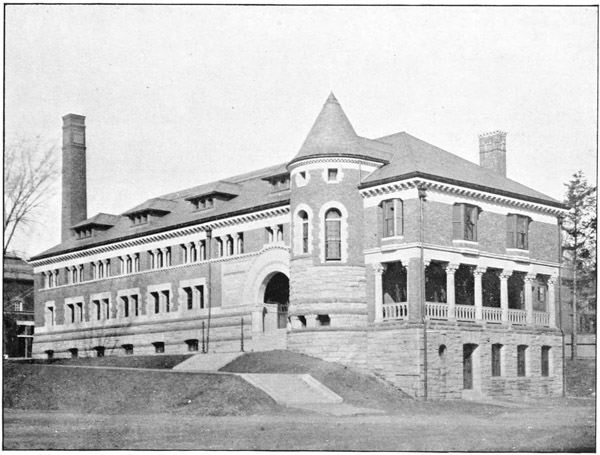
The following claims are made for the “STANDARD” Bowling Alleys, and have been sustained by use:
KEEP LEVEL. On account of the air space underneath them, which is ventilated by openings, the beds are less affected by moisture rising from the ground, cement, etc.
SURFACE. The bed being glued up of strips having rabbets cut on the sides, form a solid bed in which no piece can get loose, slip, raise up, or give any trouble.
FOUNDATIONS. Practically, no foundation is required; hence, a great saving is effected. The sills can be laid on a tar concrete or cement floor, or on piers or posts set three feet in the ground. All sills are supplied by us. As no part of the foundation is buried in cement, it lasts indefinitely.
WEAR AND TEAR. By long experience we have ascertained the best materials and forms to stand the severe usage of public and club alleys and by their use avoid the vexatious break-downs formerly so common on alleys.
EXPERIENCE. As we build a great many alleys our workmen are accustomed to the work and know its requirements. Our alleys are not experiments; they are tried and proved successes.
DURABILITY. The beds being made of double kiln dried White Rock Maple, last longer and do not require so much re-planing as if made of softer woods or maple as ordinarily seasoned.
RE-PLANING. The strips of which the beds are made do not dry out and have cracks between them that fill with grit and make re-planing almost impossible.
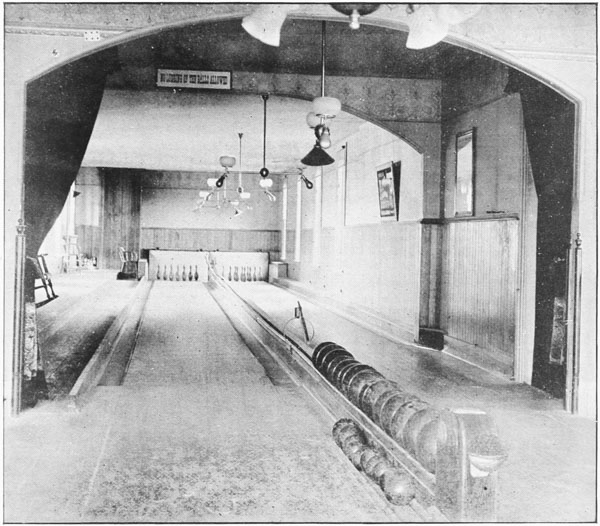

MAPLE is unquestionably the best wood for alley beds. It is hard, white, durable, even grained and when properly seasoned and dried, will remain as laid without shrinking or warping. That is, the best maple will do all this. We are large buyers of maple for alleys and other purposes, and get direct from the mills the highest grade of Hard, White (Rock) Maple. Such stock as is never carried by city yards—they have no call for it. This fine stock enables us to build alley beds that are clear white from end to end, without spots or streaks, level and true. The ideal bowling surfaces.
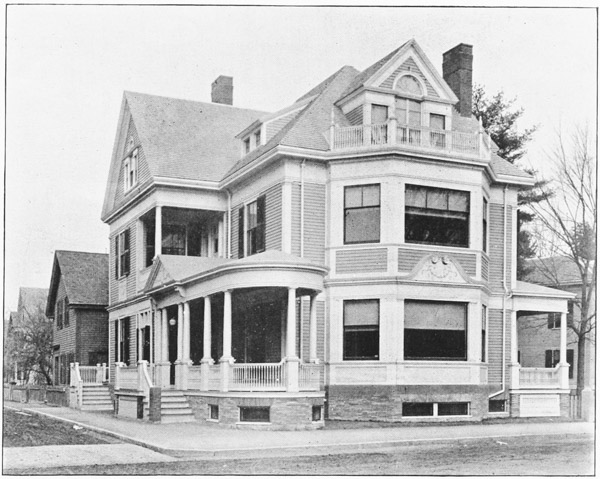

LOW Posts and runs are an innovation we introduced three or four years ago. Their advantages were apparent from the start and now nothing else will be tolerated. They give both players and spectators an unobstructed view of the alley beds and pins. In a room containing eight or ten alleys, one can see every pin. The runs are strong, the posts being short, and as the balls do not have to be raised so high to put them in the cage they are dropped in easier and wear longer.
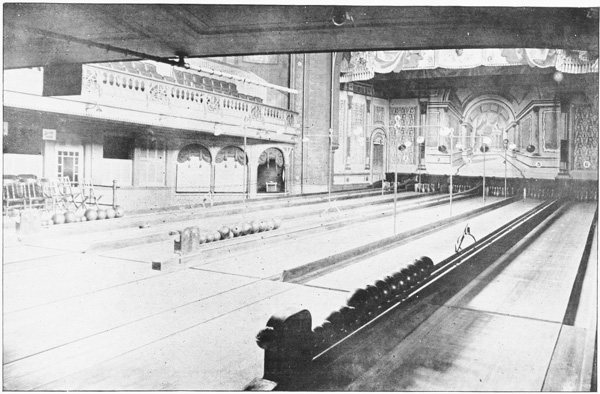

The runs are low with a low post placed inside of the scratch line. These alleys conform in every detail to the Regulations of the Massachusetts Amateur Bowling League, which are generally adopted by other Eastern organizations.
The pit is four feet wide and is dropped well below the beds so that balls go over pins or balls lying in the pit.
The swinging bunters are large, heavy, and well padded with a durable palm fibre, the padding being in sections to prevent its packing down in the bottom of the bunter. The bottom and sides of the pit are padded, and from opposite the head-pin to one foot beyond the beds, the sides, where the flying pins strike, are covered with sole leather.
The ball cage and the first section of the runs are made of hickory to stand the severe use.
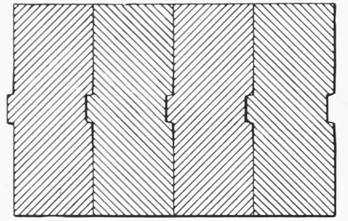
Tonguing and grooving alley stock is a feature we introduced several years ago—long enough to have given it a good test. A bed built this way, especially when glued and well nailed with cut steel nails, as ours are, is a solid plank from end to end with the tendency to warp removed by the strips having their grain in various directions. Loose or split ends that rise up and turn balls aside are an impossibility, and so close are the boards drawn to each other that it is almost impossible to find the joints. Thus the dirt is kept from working between the boards and forming unsightly cracks which let in water, when the alleys are washed, to work still more destruction.
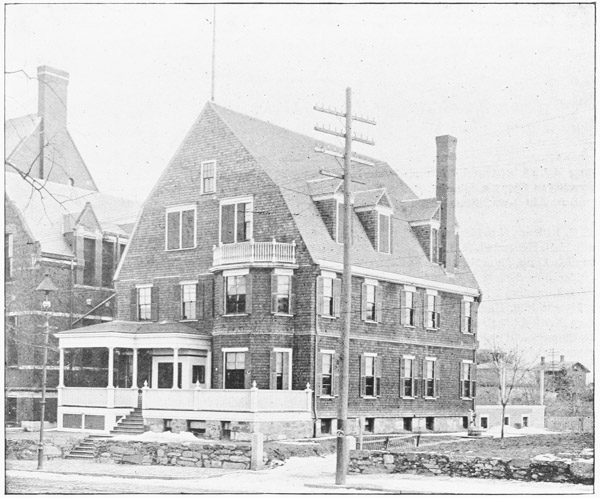
THE following is a list of Bowling Alleys laid from 1893 to 1895. The increasing number of parties using these alleys is their best recommendation.
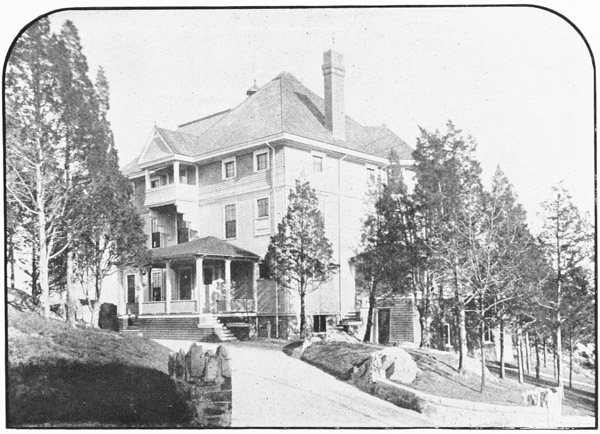
A LIST of the Reisky & Wolf Patent Alleys laid by the Narragansett Machine Co., Providence. Sole Licensees under Patent No. 359,542, for Adjustable Bowling Alleys.
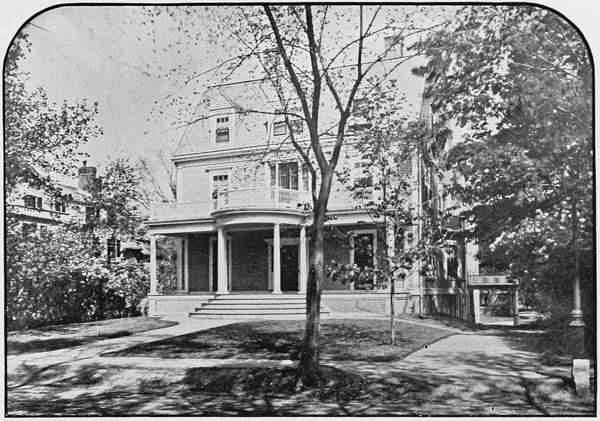
WE GUARANTEE the material and workmanship on all our alleys to be first-class in every respect and will repair free of charge, for one year, any breakage due to faulty construction or defective material; but we cannot guarantee against the natural effect of heat and moisture on the stock out of which the alleys are laid.
EXPERIENCE is a very necessary factor in building Bowling Alleys. For six years we built alleys according to the old method of setting the sleepers in cement, nailing the beds to them, etc., and though we took great care to have all work and materials first-class, our alleys did not always give the perfect satisfaction we desired. To obviate some of the troubles, in 1892 we introduced the Reisky & Wolf adjustable alleys with improvements in the construction of the beds, etc., and later the Standard non-adjustable alleys built on the same general principles. These alleys have given such excellent satisfaction that our business has largely increased, and we are confident that every alley we build according to our new method will give perfect satisfaction.
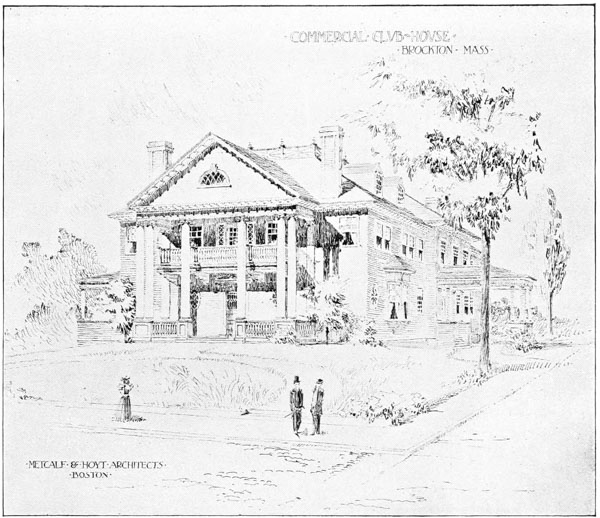
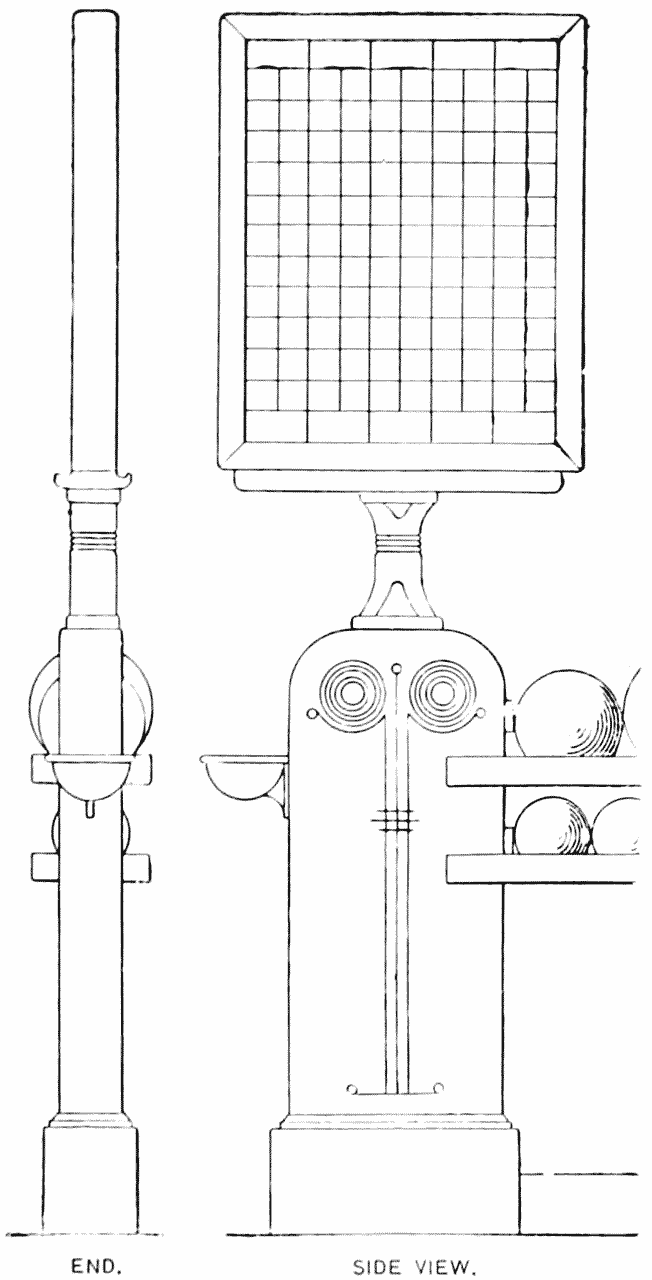
WHEN desired we build High Runs and Newel Post as shown by the drawing on this page. As will be seen by the “end view,” this post is made thin to allow as much room as possible for the bowlers. This style of runway has a sift-out that delivers the small balls on a lower rack.
OUR FACTORY, as will be seen by the illustration on page 24, is located at Woodlawn, a suburb of Providence, on the New York, New Haven Railroad. The lumber sheds and dry kilns, of improved construction, are by the side of a siding or switch built specially for us, enabling us to load our lumber or ship goods directly from the cars. We buy the highest grade lumber in car-loads direct from the mills, and have the latest improved machinery for working it. With the best of facilities and experienced workmen, we can promise first-class work.
| Size. in. Diameter |
Weight. lb., solid |
Weight. lb., bored |
Tel. Code. |
|---|---|---|---|
| 4 | 1 ⅝ | · | (MAGNET) |
| 4 ½ | 2 ¼ | · | (MAGPIE) |
| 5 | 3 ⅛ | · | (MALADY) |
| 5 ½ | 4 ⅛ | · | (MALICE) |
| 6 | 5 ⅜ | · | (MALLET) |
| 6 ½ | 6 ⅞ | · | (MAMMON) |
| 7 | 8 ½ | · | (MANAGE) |
| 7 ½ | 10 ½ | 10 ¼ | (MANGLE) |
| 8 | 12 ¾ | 12 ½ | (MANNER) |
| 8 ½ | 15 ⅜ | 15 | (MANTLE) |
| 8.59† | 16 ⅛ | 15 ¾ | (MANUAL) |
| † Regulation size, 27 in. circumference | |||
These Balls are made of the best lignum-vitæ, or ball wood as it is termed by the trade. 7 ½ in. and all larger sizes have finger holes, unless otherwise ordered. Holes are bored 3 ½ in. apart unless ordered otherwise.
Sizes measured before re-turning.
Turned from selected Rock Maple, turned to regulation sizes and lathe polished.
| Small | 12 ½ in. cir. | 14 ½ high, per set, | (MARKET) | $4.00 |
| Regulation | 15 in. cir. | 15 high, per set, | (MARROW) | 5.00 |
| Large | 17 ½ in. cir. | 18 ½ high, per set, | (MARTYR) | 6.00 |
| Poney Pins | 9 in. cir. | 9 high, per set, | (MATURE) | 2.00 |
| Candle Pins | 2 ½ in dia. | 15 high, per set, | (MERCER) | 2.40 |
The following list is well adapted for one pair of Public or Club Alleys. For a Single Alley take half of the list of Balls and Pins. It is desirable to purchase large balls at first as they turn to smaller sizes.
| 4 Regulation Balls | $20.00 |
| 2 Balls, 8 ½ in. diam. | 9.00 |
| 2 Balls, 8 in. diam. | 8.00 |
| 2 Balls, 7 in. diam. | 6.00 |
| 2 Balls, 6 in. diam. | 4.00 |
| 4 Balls, 4 ½ in. diam. | 5.00 |
| $52.00 | |
| 2 Sets of Match Pins | 10.00 |
| 1 Foot Chalk Box | 1.25 |
| 1 Winn’s Ball Retarder | 10.00 |
| Foot Chalk in Box, made to be cut down as the chalk wears, | $1.25 |
| Score Books bound in cloth, size 9 × 11 ½ in., with American League Rules. | |
| No. 1, 60 Games, | 1.25 |
| No. 2, 120 Games, | 1.75 |
| No. 3, 176 Games, | 2.50 |
| Standard Dressing, for use after washing, to preserve the surface and retain the color of the wood. In gallon cans. Per gallon | .75 |
| Savogran, for cleaning alleys, 1 lb. package, | .25 |
| Savogran, for cleaning alleys, 5 lb. package, | 1.00 |
Some means for retarding or reducing the speed of returned balls is an absolute necessity, otherwise they crash into each other making a disagreeable noise, injure the balls and knock the smaller ones off the runs. When taking a ball off the runs bowlers have often had their fingers badly crushed by a swiftly returned ball.
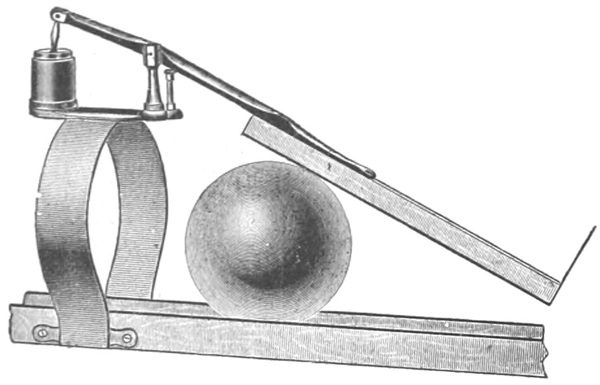
It is desirable to return balls as swiftly as possible to save time and get a favorite ball back without delay.
The retarder shown above was invented by a bowler and is perfection itself in operation. The resistance is greater for large and swift balls, and very little on slow or small balls. The resistance is affected by the air chamber under the short end of the lever which has an outlet for the compressed air controlled by a set screw so it can be adjusted. The long end of the lever has a wooden shoe with leather on the under side. A large ball raises this shoe high, compressing the air, a quick ball raises it quickly and is resisted by the compressed air which can only escape slowly. A small quick ball raises the shoe a short distance quickly and is held back by the shoe while a small slow ball passes under with scarcely any resistance.
The retarder will save its cost in the wear of the balls in a single year and give comfort and safety to the bowlers. It can be secured to any runway about 10 feet from the post in a few minutes, screws being sent with each retarder.
These lockers are adapted for public alleys and form a safe receptacle for the coats, hats, etc. of the bowlers. They are built in sections, to be easily set up, and other lockers may be added to a cabinet at any time.
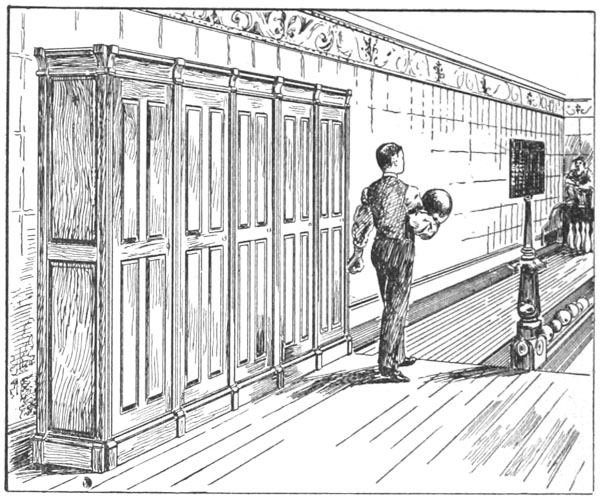
| Whitewood Locker 7 feet high (6 ft. inside), 18 in. square, with lock, knocked down on cars in Providence | net each. $6.00 |
| Ball Lockers; 12 in a cabinet, each locker holding two Regulation Balls; locks on doors all different; net price for cabinet with oak front and ends | 30.00 |
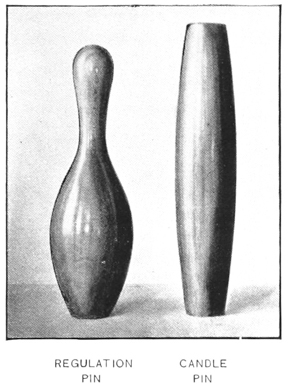
We are prepared to furnish balls, pins, or any other supplies, all of the best obtainable quality. Our alley balls are turned from the best lignum vitæ and we make our pins of first quality Rock Maple, to the form prescribed by the Bowling League.
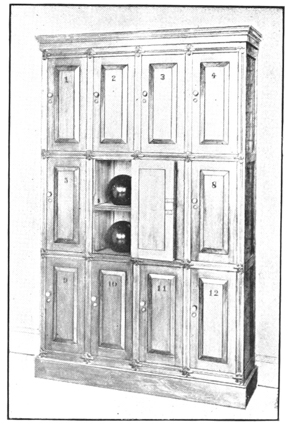
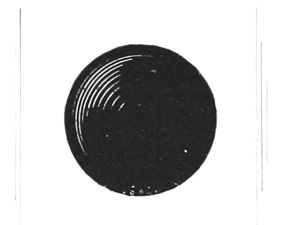
For members of clubs to keep private balls for their own use.
These Lockers are used in many clubs to keep the private ball of the members separate from those in general use. They are generally made of oak with twelve lockers in a cabinet, but may be made of any other material or number of lockers.

The necessary dimensions for “Regulation” Bowling Alleys are given on the blue print bound in opposite this page. The required space should be absolutely free from columns, piers, pipes, etc. Any such projection will prevent the alleys from being full “Regulation” size as required in match games. More space at the end of the “Run” for spectators is desirable, but not necessary. A space 5 ft. wide and 6 in. deep for the pit should be provided; the rest of the floor or ground should be level as shown in section on the blue print.
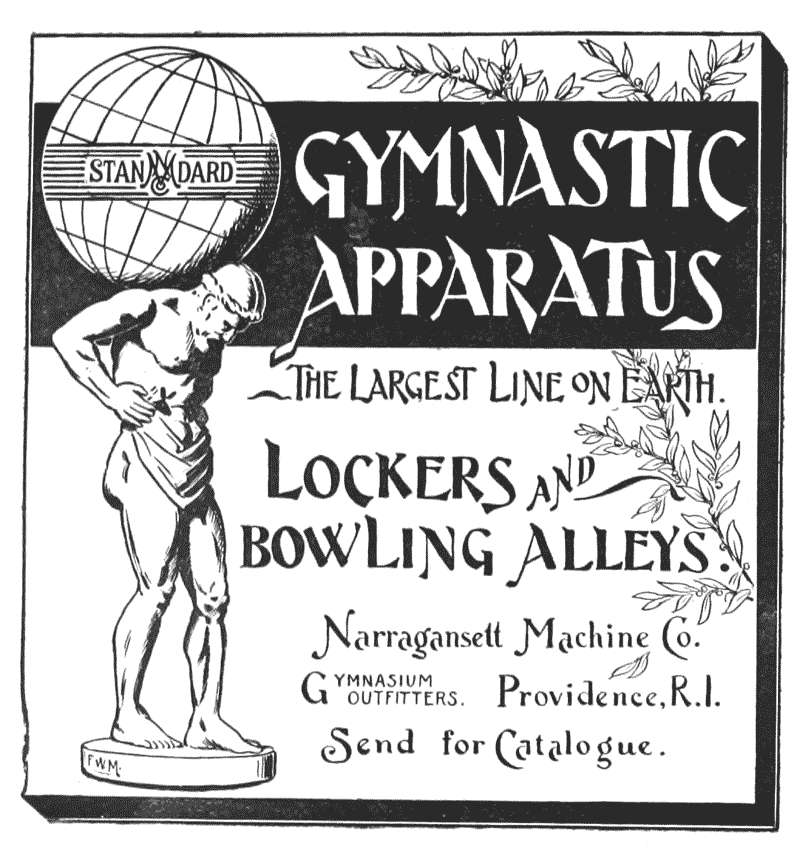
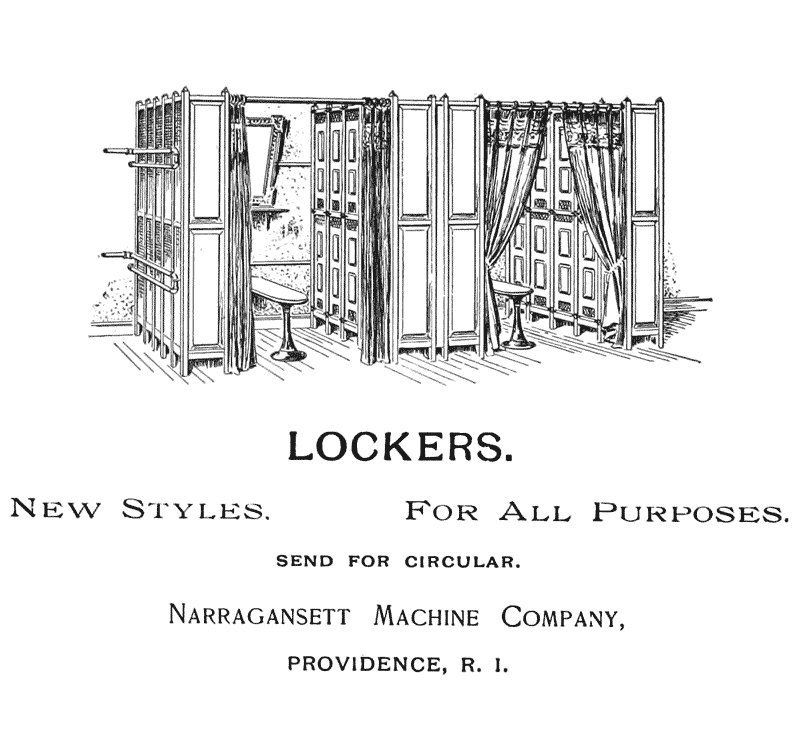
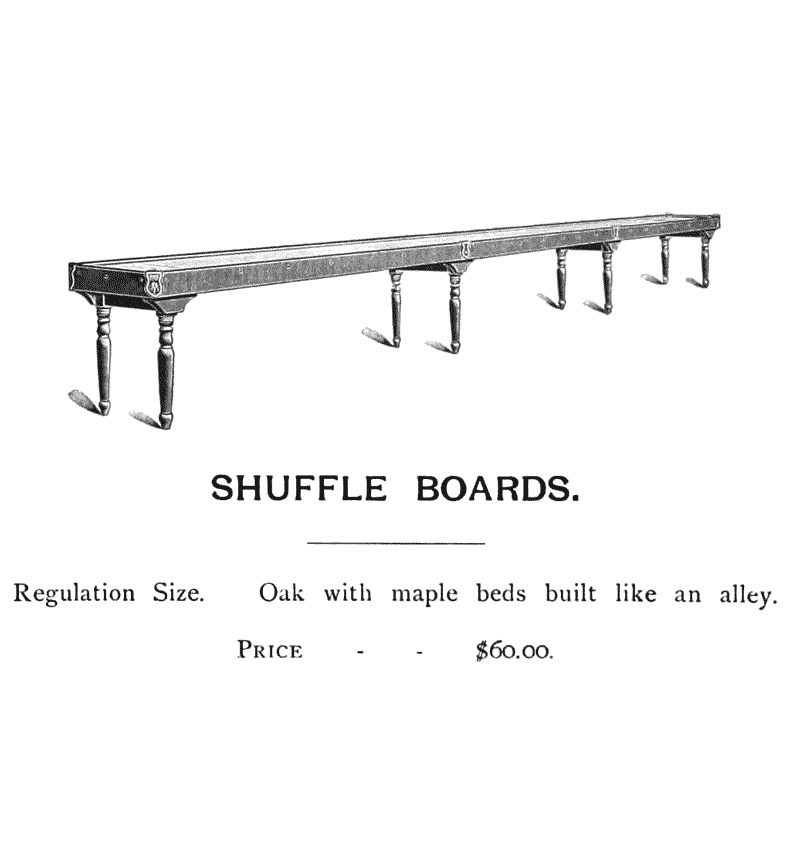

Original spelling and grammar have been generally retained, with some exceptions noted below. The transcriber produced the cover image and hereby assigns it to the public domain. Original page images are available from archive.org—search for “bowlingcataloge00narr”.
End of Project Gutenberg's Bowling Catalog E, by Narragansett Machine Company
*** END OF THIS PROJECT GUTENBERG EBOOK BOWLING CATALOG E ***
***** This file should be named 57337-h.htm or 57337-h.zip *****
This and all associated files of various formats will be found in:
http://www.gutenberg.org/5/7/3/3/57337/
Produced by ellinora, RichardW, and the Online Distributed
Proofreading Team at http://www.pgdp.net (This file was
produced from images generously made available by The
Internet Archive/American Libraries.)
Updated editions will replace the previous one--the old editions will
be renamed.
Creating the works from print editions not protected by U.S. copyright
law means that no one owns a United States copyright in these works,
so the Foundation (and you!) can copy and distribute it in the United
States without permission and without paying copyright
royalties. Special rules, set forth in the General Terms of Use part
of this license, apply to copying and distributing Project
Gutenberg-tm electronic works to protect the PROJECT GUTENBERG-tm
concept and trademark. Project Gutenberg is a registered trademark,
and may not be used if you charge for the eBooks, unless you receive
specific permission. If you do not charge anything for copies of this
eBook, complying with the rules is very easy. You may use this eBook
for nearly any purpose such as creation of derivative works, reports,
performances and research. They may be modified and printed and given
away--you may do practically ANYTHING in the United States with eBooks
not protected by U.S. copyright law. Redistribution is subject to the
trademark license, especially commercial redistribution.
START: FULL LICENSE
THE FULL PROJECT GUTENBERG LICENSE
PLEASE READ THIS BEFORE YOU DISTRIBUTE OR USE THIS WORK
To protect the Project Gutenberg-tm mission of promoting the free
distribution of electronic works, by using or distributing this work
(or any other work associated in any way with the phrase "Project
Gutenberg"), you agree to comply with all the terms of the Full
Project Gutenberg-tm License available with this file or online at
www.gutenberg.org/license.
Section 1. General Terms of Use and Redistributing Project
Gutenberg-tm electronic works
1.A. By reading or using any part of this Project Gutenberg-tm
electronic work, you indicate that you have read, understand, agree to
and accept all the terms of this license and intellectual property
(trademark/copyright) agreement. If you do not agree to abide by all
the terms of this agreement, you must cease using and return or
destroy all copies of Project Gutenberg-tm electronic works in your
possession. If you paid a fee for obtaining a copy of or access to a
Project Gutenberg-tm electronic work and you do not agree to be bound
by the terms of this agreement, you may obtain a refund from the
person or entity to whom you paid the fee as set forth in paragraph
1.E.8.
1.B. "Project Gutenberg" is a registered trademark. It may only be
used on or associated in any way with an electronic work by people who
agree to be bound by the terms of this agreement. There are a few
things that you can do with most Project Gutenberg-tm electronic works
even without complying with the full terms of this agreement. See
paragraph 1.C below. There are a lot of things you can do with Project
Gutenberg-tm electronic works if you follow the terms of this
agreement and help preserve free future access to Project Gutenberg-tm
electronic works. See paragraph 1.E below.
1.C. The Project Gutenberg Literary Archive Foundation ("the
Foundation" or PGLAF), owns a compilation copyright in the collection
of Project Gutenberg-tm electronic works. Nearly all the individual
works in the collection are in the public domain in the United
States. If an individual work is unprotected by copyright law in the
United States and you are located in the United States, we do not
claim a right to prevent you from copying, distributing, performing,
displaying or creating derivative works based on the work as long as
all references to Project Gutenberg are removed. Of course, we hope
that you will support the Project Gutenberg-tm mission of promoting
free access to electronic works by freely sharing Project Gutenberg-tm
works in compliance with the terms of this agreement for keeping the
Project Gutenberg-tm name associated with the work. You can easily
comply with the terms of this agreement by keeping this work in the
same format with its attached full Project Gutenberg-tm License when
you share it without charge with others.
1.D. The copyright laws of the place where you are located also govern
what you can do with this work. Copyright laws in most countries are
in a constant state of change. If you are outside the United States,
check the laws of your country in addition to the terms of this
agreement before downloading, copying, displaying, performing,
distributing or creating derivative works based on this work or any
other Project Gutenberg-tm work. The Foundation makes no
representations concerning the copyright status of any work in any
country outside the United States.
1.E. Unless you have removed all references to Project Gutenberg:
1.E.1. The following sentence, with active links to, or other
immediate access to, the full Project Gutenberg-tm License must appear
prominently whenever any copy of a Project Gutenberg-tm work (any work
on which the phrase "Project Gutenberg" appears, or with which the
phrase "Project Gutenberg" is associated) is accessed, displayed,
performed, viewed, copied or distributed:
This eBook is for the use of anyone anywhere in the United States and
most other parts of the world at no cost and with almost no
restrictions whatsoever. You may copy it, give it away or re-use it
under the terms of the Project Gutenberg License included with this
eBook or online at www.gutenberg.org. If you are not located in the
United States, you'll have to check the laws of the country where you
are located before using this ebook.
1.E.2. If an individual Project Gutenberg-tm electronic work is
derived from texts not protected by U.S. copyright law (does not
contain a notice indicating that it is posted with permission of the
copyright holder), the work can be copied and distributed to anyone in
the United States without paying any fees or charges. If you are
redistributing or providing access to a work with the phrase "Project
Gutenberg" associated with or appearing on the work, you must comply
either with the requirements of paragraphs 1.E.1 through 1.E.7 or
obtain permission for the use of the work and the Project Gutenberg-tm
trademark as set forth in paragraphs 1.E.8 or 1.E.9.
1.E.3. If an individual Project Gutenberg-tm electronic work is posted
with the permission of the copyright holder, your use and distribution
must comply with both paragraphs 1.E.1 through 1.E.7 and any
additional terms imposed by the copyright holder. Additional terms
will be linked to the Project Gutenberg-tm License for all works
posted with the permission of the copyright holder found at the
beginning of this work.
1.E.4. Do not unlink or detach or remove the full Project Gutenberg-tm
License terms from this work, or any files containing a part of this
work or any other work associated with Project Gutenberg-tm.
1.E.5. Do not copy, display, perform, distribute or redistribute this
electronic work, or any part of this electronic work, without
prominently displaying the sentence set forth in paragraph 1.E.1 with
active links or immediate access to the full terms of the Project
Gutenberg-tm License.
1.E.6. You may convert to and distribute this work in any binary,
compressed, marked up, nonproprietary or proprietary form, including
any word processing or hypertext form. However, if you provide access
to or distribute copies of a Project Gutenberg-tm work in a format
other than "Plain Vanilla ASCII" or other format used in the official
version posted on the official Project Gutenberg-tm web site
(www.gutenberg.org), you must, at no additional cost, fee or expense
to the user, provide a copy, a means of exporting a copy, or a means
of obtaining a copy upon request, of the work in its original "Plain
Vanilla ASCII" or other form. Any alternate format must include the
full Project Gutenberg-tm License as specified in paragraph 1.E.1.
1.E.7. Do not charge a fee for access to, viewing, displaying,
performing, copying or distributing any Project Gutenberg-tm works
unless you comply with paragraph 1.E.8 or 1.E.9.
1.E.8. You may charge a reasonable fee for copies of or providing
access to or distributing Project Gutenberg-tm electronic works
provided that
* You pay a royalty fee of 20% of the gross profits you derive from
the use of Project Gutenberg-tm works calculated using the method
you already use to calculate your applicable taxes. The fee is owed
to the owner of the Project Gutenberg-tm trademark, but he has
agreed to donate royalties under this paragraph to the Project
Gutenberg Literary Archive Foundation. Royalty payments must be paid
within 60 days following each date on which you prepare (or are
legally required to prepare) your periodic tax returns. Royalty
payments should be clearly marked as such and sent to the Project
Gutenberg Literary Archive Foundation at the address specified in
Section 4, "Information about donations to the Project Gutenberg
Literary Archive Foundation."
* You provide a full refund of any money paid by a user who notifies
you in writing (or by e-mail) within 30 days of receipt that s/he
does not agree to the terms of the full Project Gutenberg-tm
License. You must require such a user to return or destroy all
copies of the works possessed in a physical medium and discontinue
all use of and all access to other copies of Project Gutenberg-tm
works.
* You provide, in accordance with paragraph 1.F.3, a full refund of
any money paid for a work or a replacement copy, if a defect in the
electronic work is discovered and reported to you within 90 days of
receipt of the work.
* You comply with all other terms of this agreement for free
distribution of Project Gutenberg-tm works.
1.E.9. If you wish to charge a fee or distribute a Project
Gutenberg-tm electronic work or group of works on different terms than
are set forth in this agreement, you must obtain permission in writing
from both the Project Gutenberg Literary Archive Foundation and The
Project Gutenberg Trademark LLC, the owner of the Project Gutenberg-tm
trademark. Contact the Foundation as set forth in Section 3 below.
1.F.
1.F.1. Project Gutenberg volunteers and employees expend considerable
effort to identify, do copyright research on, transcribe and proofread
works not protected by U.S. copyright law in creating the Project
Gutenberg-tm collection. Despite these efforts, Project Gutenberg-tm
electronic works, and the medium on which they may be stored, may
contain "Defects," such as, but not limited to, incomplete, inaccurate
or corrupt data, transcription errors, a copyright or other
intellectual property infringement, a defective or damaged disk or
other medium, a computer virus, or computer codes that damage or
cannot be read by your equipment.
1.F.2. LIMITED WARRANTY, DISCLAIMER OF DAMAGES - Except for the "Right
of Replacement or Refund" described in paragraph 1.F.3, the Project
Gutenberg Literary Archive Foundation, the owner of the Project
Gutenberg-tm trademark, and any other party distributing a Project
Gutenberg-tm electronic work under this agreement, disclaim all
liability to you for damages, costs and expenses, including legal
fees. YOU AGREE THAT YOU HAVE NO REMEDIES FOR NEGLIGENCE, STRICT
LIABILITY, BREACH OF WARRANTY OR BREACH OF CONTRACT EXCEPT THOSE
PROVIDED IN PARAGRAPH 1.F.3. YOU AGREE THAT THE FOUNDATION, THE
TRADEMARK OWNER, AND ANY DISTRIBUTOR UNDER THIS AGREEMENT WILL NOT BE
LIABLE TO YOU FOR ACTUAL, DIRECT, INDIRECT, CONSEQUENTIAL, PUNITIVE OR
INCIDENTAL DAMAGES EVEN IF YOU GIVE NOTICE OF THE POSSIBILITY OF SUCH
DAMAGE.
1.F.3. LIMITED RIGHT OF REPLACEMENT OR REFUND - If you discover a
defect in this electronic work within 90 days of receiving it, you can
receive a refund of the money (if any) you paid for it by sending a
written explanation to the person you received the work from. If you
received the work on a physical medium, you must return the medium
with your written explanation. The person or entity that provided you
with the defective work may elect to provide a replacement copy in
lieu of a refund. If you received the work electronically, the person
or entity providing it to you may choose to give you a second
opportunity to receive the work electronically in lieu of a refund. If
the second copy is also defective, you may demand a refund in writing
without further opportunities to fix the problem.
1.F.4. Except for the limited right of replacement or refund set forth
in paragraph 1.F.3, this work is provided to you 'AS-IS', WITH NO
OTHER WARRANTIES OF ANY KIND, EXPRESS OR IMPLIED, INCLUDING BUT NOT
LIMITED TO WARRANTIES OF MERCHANTABILITY OR FITNESS FOR ANY PURPOSE.
1.F.5. Some states do not allow disclaimers of certain implied
warranties or the exclusion or limitation of certain types of
damages. If any disclaimer or limitation set forth in this agreement
violates the law of the state applicable to this agreement, the
agreement shall be interpreted to make the maximum disclaimer or
limitation permitted by the applicable state law. The invalidity or
unenforceability of any provision of this agreement shall not void the
remaining provisions.
1.F.6. INDEMNITY - You agree to indemnify and hold the Foundation, the
trademark owner, any agent or employee of the Foundation, anyone
providing copies of Project Gutenberg-tm electronic works in
accordance with this agreement, and any volunteers associated with the
production, promotion and distribution of Project Gutenberg-tm
electronic works, harmless from all liability, costs and expenses,
including legal fees, that arise directly or indirectly from any of
the following which you do or cause to occur: (a) distribution of this
or any Project Gutenberg-tm work, (b) alteration, modification, or
additions or deletions to any Project Gutenberg-tm work, and (c) any
Defect you cause.
Section 2. Information about the Mission of Project Gutenberg-tm
Project Gutenberg-tm is synonymous with the free distribution of
electronic works in formats readable by the widest variety of
computers including obsolete, old, middle-aged and new computers. It
exists because of the efforts of hundreds of volunteers and donations
from people in all walks of life.
Volunteers and financial support to provide volunteers with the
assistance they need are critical to reaching Project Gutenberg-tm's
goals and ensuring that the Project Gutenberg-tm collection will
remain freely available for generations to come. In 2001, the Project
Gutenberg Literary Archive Foundation was created to provide a secure
and permanent future for Project Gutenberg-tm and future
generations. To learn more about the Project Gutenberg Literary
Archive Foundation and how your efforts and donations can help, see
Sections 3 and 4 and the Foundation information page at
www.gutenberg.org
Section 3. Information about the Project Gutenberg Literary Archive Foundation
The Project Gutenberg Literary Archive Foundation is a non profit
501(c)(3) educational corporation organized under the laws of the
state of Mississippi and granted tax exempt status by the Internal
Revenue Service. The Foundation's EIN or federal tax identification
number is 64-6221541. Contributions to the Project Gutenberg Literary
Archive Foundation are tax deductible to the full extent permitted by
U.S. federal laws and your state's laws.
The Foundation's principal office is in Fairbanks, Alaska, with the
mailing address: PO Box 750175, Fairbanks, AK 99775, but its
volunteers and employees are scattered throughout numerous
locations. Its business office is located at 809 North 1500 West, Salt
Lake City, UT 84116, (801) 596-1887. Email contact links and up to
date contact information can be found at the Foundation's web site and
official page at www.gutenberg.org/contact
For additional contact information:
Dr. Gregory B. Newby
Chief Executive and Director
gbnewby@pglaf.org
Section 4. Information about Donations to the Project Gutenberg
Literary Archive Foundation
Project Gutenberg-tm depends upon and cannot survive without wide
spread public support and donations to carry out its mission of
increasing the number of public domain and licensed works that can be
freely distributed in machine readable form accessible by the widest
array of equipment including outdated equipment. Many small donations
($1 to $5,000) are particularly important to maintaining tax exempt
status with the IRS.
The Foundation is committed to complying with the laws regulating
charities and charitable donations in all 50 states of the United
States. Compliance requirements are not uniform and it takes a
considerable effort, much paperwork and many fees to meet and keep up
with these requirements. We do not solicit donations in locations
where we have not received written confirmation of compliance. To SEND
DONATIONS or determine the status of compliance for any particular
state visit www.gutenberg.org/donate
While we cannot and do not solicit contributions from states where we
have not met the solicitation requirements, we know of no prohibition
against accepting unsolicited donations from donors in such states who
approach us with offers to donate.
International donations are gratefully accepted, but we cannot make
any statements concerning tax treatment of donations received from
outside the United States. U.S. laws alone swamp our small staff.
Please check the Project Gutenberg Web pages for current donation
methods and addresses. Donations are accepted in a number of other
ways including checks, online payments and credit card donations. To
donate, please visit: www.gutenberg.org/donate
Section 5. General Information About Project Gutenberg-tm electronic works.
Professor Michael S. Hart was the originator of the Project
Gutenberg-tm concept of a library of electronic works that could be
freely shared with anyone. For forty years, he produced and
distributed Project Gutenberg-tm eBooks with only a loose network of
volunteer support.
Project Gutenberg-tm eBooks are often created from several printed
editions, all of which are confirmed as not protected by copyright in
the U.S. unless a copyright notice is included. Thus, we do not
necessarily keep eBooks in compliance with any particular paper
edition.
Most people start at our Web site which has the main PG search
facility: www.gutenberg.org
This Web site includes information about Project Gutenberg-tm,
including how to make donations to the Project Gutenberg Literary
Archive Foundation, how to help produce our new eBooks, and how to
subscribe to our email newsletter to hear about new eBooks.